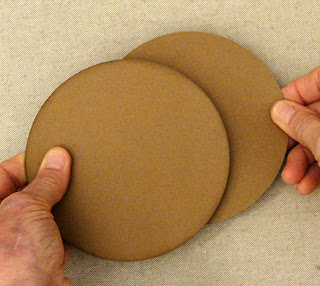Say
“thank you” to doctor, nurse, or other medical care
provider (or “get well” to loved one) with this detailed 5x7 card.
Front layers stack to create dimension
for the six
tiny windows filled with heartbeat line, tiny heart, red cross,
bottle outline with tiny pills, band-aid
(cut these double to stack for more
dimension).
Welded words “thank you” and alternative “get well”
attach across
front corner.
Hole-punched border overlay offers alternative
for adding hand
stitching.
ASSEMBLY: 1. Identify and cut the shapes:
A card base with horizontal center perforation
B top layer frame (model uses punched version
for real stitching application)
C frame layer 2 - shows thru as narrow border
D 'mat' layer offset frame - matches windows layer
(NOTE: can use the 'waste' rectangle as liner for windows
under-layer instead of card base 'show-thru' if preferred:
see next photo for explanation)
E windows layer
F liner for windows layer - provides extra depth
*window content elements - cut layers for build up
G thank you (or get well) word cuts (2*)
H heart beat line (2*)
I pills (9 pieces)
J pill bottle base, outline layers (2*)
K bandaid, inset, pad
L hearts (2 layers of 2*), red cross (2*)
NOTE: the 'waste' from D frame is the perfect size
to act as 'liner' for the backside of the windows under-layer
if the card base which otherwise would show thru is NOT
a desirable color choice.
2. The sample card uses the real stitch detail on
the top frame layer. If you are NOT using that version,
you can skip forward to Step 3.
The 'thread' used for this project is DMC perle cotton
in BLACK no. 5 (obtain contrast yarn of choice)
along with tapestry-style needles in a gauge that will
fit easily through the cut stitching holes.
(Size 24 was used for this project.)
Cut a 28-20" length of 'thread', load needle, anchor
the lead end with a small piece of cello tape at
one corner on backside, then insert needle up at
corner hole, insert down at second holes, and so forth . . .
. . . to create stitches between the 'long' spacing of
holes, and skip the 'short' spaces, as shown here.
When the stitching circuit is completed, the finalhole insertion will carry the yarn through to backside
where the tail is trimmed to approx. 1/2" and held
in place with another small piece of tape.
3. Position the top frame layer over the second
frame layer (narrow border show-thru), align outer
edges precisely, and attach in place.
4. Position the windows frame build up layer
behind the main windows frame layer, line up
the window opening edges precisely, and attach.
5. Position and attach the 'mat' frame layer over top of
window frames assembly, aligning outer edges
precisely.
6. If needed, position the 'waste' rectangle panel
behind the back of windows/frame assembly,
adjust to make sure the openings are covered
with extra margin approx. equal all around, and attach.
7. Position the top frames assembly over the topof the mat/window frames assembly, align outer
edges precisely, and attach in place.
8. Fold the card base in half, inside surfaces together.
9. Position the frames assembly over the top of
card base front, adjust for even offset margin
all around, and attach in place, including the window
frame interior members.
9. Prepare the window contents elements:
band aid: identify the shapes, then . . .
position and glue the 'pad' shape over the top;
other elements as shown have double shapes
which should be layered and attached together
for added dimension;
pill bottle - layer outlines, then layer onto base.
10. Position the elements into their respective
windows. NOTE: heart beat ends need to be
tucked under the side edges of frame;
pill shapes are placed inside and to the side of
the bottle shape.
Position and attach the words shape across
the upper left corner diagonally, as shown.
Here is the completed card.

































































































